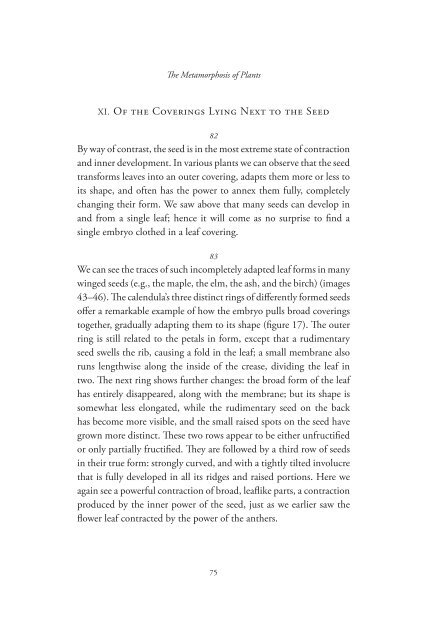Libro - GOETHE - The Metamorphosis of Plants
You also want an ePaper? Increase the reach of your titles
YUMPU automatically turns print PDFs into web optimized ePapers that Google loves.
<strong>The</strong> <strong>Metamorphosis</strong> <strong>of</strong> <strong>Plants</strong><br />
XI. Of the Coverings Lying Next to the Seed<br />
82<br />
By way <strong>of</strong> contrast, the seed is in the most extreme state <strong>of</strong> contraction<br />
and inner development. In various plants we can observe that the seed<br />
transforms leaves into an outer covering, adapts them more or less to<br />
its shape, and <strong>of</strong>ten has the power to annex them fully, completely<br />
changing their form. We saw above that many seeds can develop in<br />
and from a single leaf; hence it will come as no surprise to find a<br />
single embryo clothed in a leaf covering.<br />
83<br />
We can see the traces <strong>of</strong> such incompletely adapted leaf forms in many<br />
winged seeds (e.g., the maple, the elm, the ash, and the birch) (images<br />
43–46). <strong>The</strong> calendula’s three distinct rings <strong>of</strong> differently formed seeds<br />
<strong>of</strong>fer a remarkable example <strong>of</strong> how the embryo pulls broad coverings<br />
together, gradually adapting them to its shape (figure 17). <strong>The</strong> outer<br />
ring is still related to the petals in form, except that a rudimentary<br />
seed swells the rib, causing a fold in the leaf; a small membrane also<br />
runs lengthwise along the inside <strong>of</strong> the crease, dividing the leaf in<br />
two. <strong>The</strong> next ring shows further changes: the broad form <strong>of</strong> the leaf<br />
has entirely disappeared, along with the membrane; but its shape is<br />
somewhat less elongated, while the rudimentary seed on the back<br />
has become more visible, and the small raised spots on the seed have<br />
grown more distinct. <strong>The</strong>se two rows appear to be either unfructified<br />
or only partially fructified. <strong>The</strong>y are followed by a third row <strong>of</strong> seeds<br />
in their true form: strongly curved, and with a tightly tilted involucre<br />
that is fully developed in all its ridges and raised portions. Here we<br />
again see a powerful contraction <strong>of</strong> broad, leaflike parts, a contraction<br />
produced by the inner power <strong>of</strong> the seed, just as we earlier saw the<br />
flower leaf contracted by the power <strong>of</strong> the anthers.<br />
75



